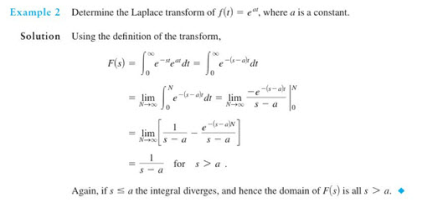What's the significance of negative exponents in Laplace transformations
- Thread starter Integrate
- Start date
As MaxWong said, while solving the integral it does not matter which structure you use. But for convenience, it is better to make it look like e−(s−a)t for two reasons. The first reason is that the transformation answer will involve the expression (s−a) rather than (a−s). The second reason is that it is some kind of a reminder to tell you that s>a.View attachment 37975
In the photo above why can't leave it as e^t(a-s)?
Why do we need to take out a negative to convert it to e^-t(s-a)
Another way to see this is to look at this function, e−at. The convenient structure will be e−(s+a)t because the answer is s+a1 which involves the expression (s+a).
Integrate
Junior Member
- Joined
- May 17, 2018
- Messages
- 129
This was a very helpful answer. Thank you.As MaxWong said, while solving the integral it does not matter which structure you use. But for convenience, it is better to make it look like e−(s−a)t for two reasons. The first reason is that the transformation answer will involve the expression (s−a) rather than (a−s). The second reason is that it is some kind of a reminder to tell you that s>a.
Another way to see this is to look at this function, e−at. The convenient structure will be e−(s+a)t because the answer is s+a1 which involves the expression (s+a).

